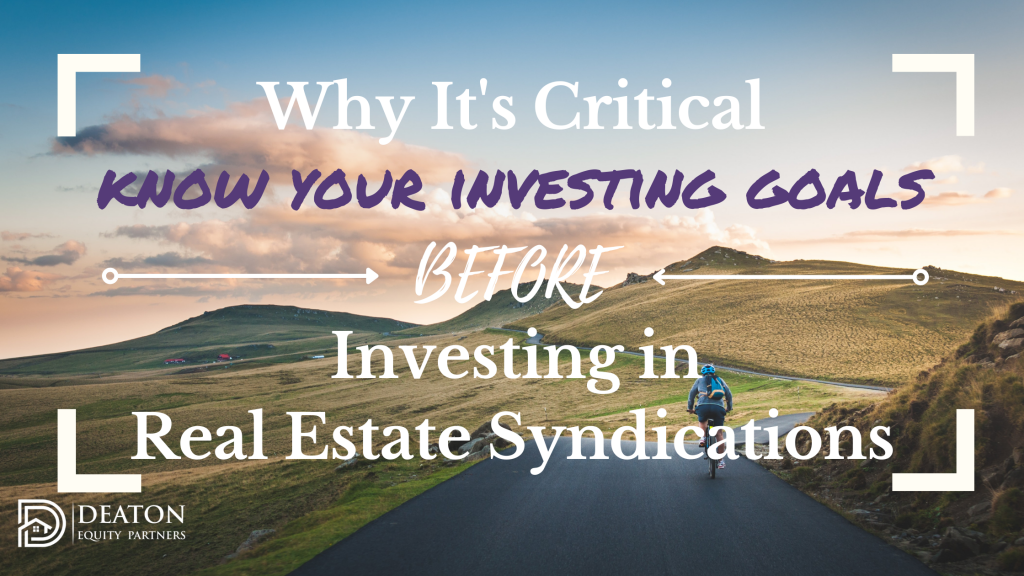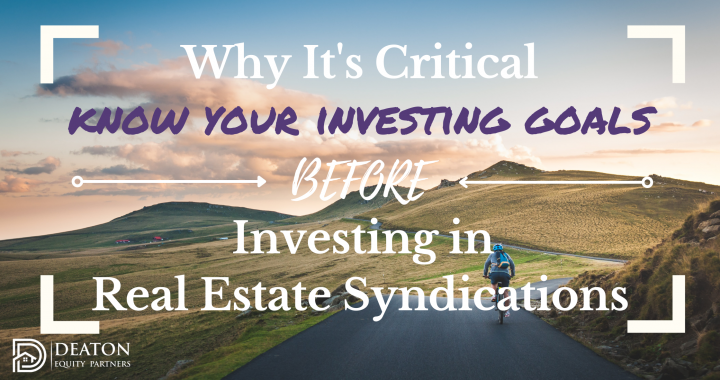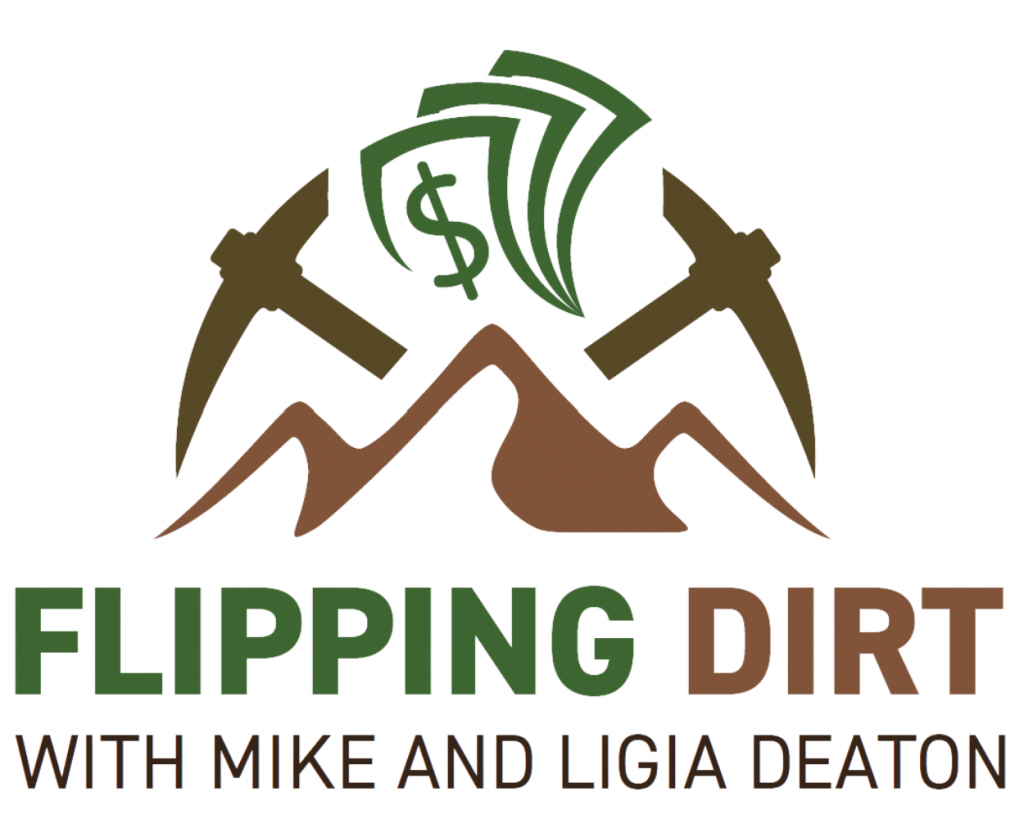Why It's Critical to Know Your Investing Goals
Before You Invest in Your First Real Estate Syndication
Take a moment to think about the process that you used to find the home you’re currently living in.
You likely had a list, however large or small, that included a specific area, a particular school district, your desired commute, and/or the number of bedrooms you were looking for. If you were looking for a three-bedroom with a big yard for the kids to play and perhaps a pool, it’s very unlikely you would have settled for (or even looked at) a one-bedroom high-rise condo, even with an awesome view.
Well, it’s the same type of situation when you’re investing in real estate. Before you even begin to consider potential investment opportunities, it’s critical you know WHY you’re investing and WHAT you’re expecting to get out of it.
Without clear goals, you can easily be tempted by slick, marketing photos and well-polished investor presentations that don’t actually align with your investing goals. Or even paralyzed by the overwhelming amount of investing options out there.
Let’s walk through a couple of examples and see if one resonates with you. With clear goals in mind, you’ll know just what to do when the right investment opportunity comes along.
Before you even begin to consider potential investment opportunities, it’s critical you know WHY you’re investing and WHAT you’re expecting to get out of it.

Investing Goal Example #1:
Investing for Cash Flow
Brian is a family man who works a corporate job full-time. While the income is great, the meetings, commute, travel and other daily (and nightly!) hassles dominate his time and takes him away from his fair share of opportunities with family and friends.
Brian wants to create and initial passive income steam of about $4,000 per month, which will help cover most of the family’s current expenses and that would give him the freedom to quit his job down the road. Finding investments that will provide steady cash flow now could eventually replace his income and allow him to be fully present with the wife and kids and enjoy a great lifestyle now.
If Brian requires $48,000 per year ($4,000 per month), he’d need to invest roughly $600,000 if expected returns are in the 8% range.
$600,000 invested x 8% cash flow returns
= $48,000 in passive income per year
With this knowledge and these numbers in mind, Brian should focus on cash flow first and foremost. That means that any investments with lower projected cash flow returns should automatically be discarded, and any opportunities reflecting 8% or higher should really command his attention.
Investing Goal Example #2:
Investing for Appreciation
Jesse, meanwhile, is single with no children, has excellent cash flow, isn’t necessarily interested in quitting his full-time job, and is more interested in potential appreciation.
He’s seen how property values have experienced huge upswings, and he loves the idea of investing in hidden gems or that are in growth areas like Austin, San Antonio or even Des Moines, Iowa. He’s aware of the higher risk and the longer amount of time he’ll have to wait until payout, but he’s okay with that since his current cash flow position is strong with a decent income and low expenses.
Even if his investment doesn’t appreciate as much as expected, that’s alright with him. He’s more interested in the “chance” that it might.
Common investment advice is that these types of investments are riskier and that you should always invest for cash flow. However, there are investors with a higher risk tolerance who will voluntarily take on the risk for the possibility of appreciation.
In this case, Jesse is aware of the pros and cons, knows that there are winners and losers in this game, and looks for deeply distressed deals in growing markets to increase his chance for high returns.
The Hybrid:
Investing for Cash Flow AND
Appreciation
But what if you didn’t really feel comfortable in either Brian’s or Jesse’s shoes, that’s okay! That just means you’re among the majority and that you’d like a mix of cash flow AND appreciation.
Hybrid investments that provide some cash flow throughout the project in addition to the potential for appreciation do exist! There are a lot of real estate investments out there located in markets with healthy appreciation (think Texas, the midwest, and even the southeast) and that present solid, value-add opportunities to ‘force’ additional appreciation.
Don’t be afraid to seek that sweet spot – where you get ongoing cash flow to cover living expenses, plus the potential for appreciation later on in the project. In many of the multifamily syndications we sponsor, investors easily achieve >8% cash flow on an annual basis and then also enjoy 150% to 200% return on your investment over 5 years. So put $250,000 in just one of these deals and the hybrid investor receives ~$25,000/year in cash flow as well as another $125,000 in appreciation. That’s a 20% average annualized return on your investment! Cha-ching!!
Know Your Goals!
Investment summaries and presentations for real estate syndication opportunities are purposely made to attract your attention with colorful graphics, nice charts and beautiful photos, which is exactly why it’s important to know your purpose for investing in the first place. You have to train yourself to see past the surface and understand the bones of the deal and your expected returns.
When a deal does come along that aligns with your goals, you’ll be able to confidently flip past those gorgeous pictures, focus on the numbers, act confidently & quickly, and start enjoy your returns…without second-guessing yourself.
Be sure to sign up for our newsletter and join the Deaton Equity Partners Passive Investor’s Group where we share even more education, investment opportunities and help you generate Passive Income…for life!



